|
List of birds of Madagascar
 Madagascar is an island nation located off the southeastern coast of Africa. Because of its long separation from neighboring continents—through tectonic movement, it split from Africa about 160 million years ago, and from India around 90 million years ago—it contains many species endemic to the island.[1] Of the 311 bird species recorded on Madagascar, 109 are found nowhere else on earth, and a handful of others are shared only with the neighbouring Comoro Islands,[2] 2 have been declared extinct, 36 are globally threatened, 7 species are introduced by humans. This list's taxonomic treatment (designation and sequence of orders, families and species) and nomenclature (common and scientific names) follow the conventions of The Clements Checklist of Birds of the World, 2022 edition. The family accounts at the beginning of each heading reflect this taxonomy, as do the species counts found in each family account. Introduced and accidental species are included in the total counts for Madagascar. Species status comments are taken from Morris and Hawkins's Birds of Madagascar: A Photographic Guide unless otherwise noted. Introduced and accidental species are included in the total counts. The IUCN Red List codes are those given by the International Union for the Conservation of Nature and Natural Resources; they come from the IUCN's Red List website.[3] Table legend (*) Species endemic to Madagascar
(%) Species introduced to Madagascar
 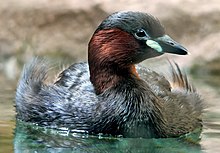   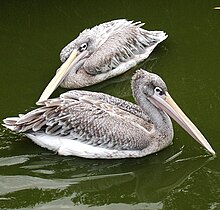     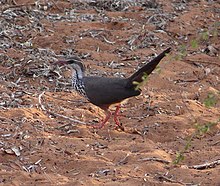  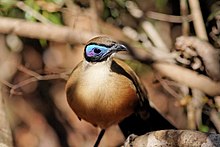  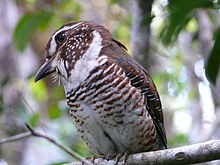 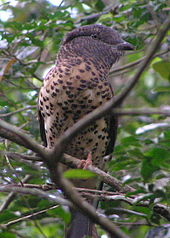   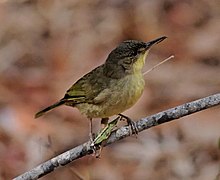 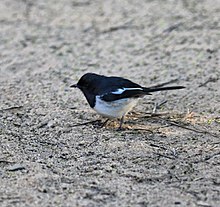   Greater elephant birdsOrder: Aepyornithiformes Family: Aepyornithidae Aepyornis is an extinct genus of elephant birds formerly endemic to Madagascar. The genus had two species, the smaller A. hildebrandti and the larger A. maximus, which is possibly the largest bird ever to have lived. Its closest relative is the New Zealand kiwi. They became extinct sometime around 1000 CE, probably as a result of human activity.
Lesser elephant birdOrder: Aepyornithiformes Family: Mullerornithidae Mullerornis modestus is an extinct species of elephant birds, and the only member of the genus Mullerornis. It is smaller than the more well-known Aepyornis, with a still substantial body mass of approximately 80 kilograms (180 lb.) A bone possibly belonging to Mullerornis has been radiocarbon dated to about 1260 BP, suggesting that the animal was still extant at the end of the first millennium.
Ducks, geese, and waterfowlOrder: Anseriformes Family: Anatidae Anatidae includes the ducks and most duck-like waterfowl, such as geese and swans. These birds are adapted to an aquatic existence with webbed feet, flattened bills, and feathers that are excellent at shedding water due to an oily coating.
GuineafowlOrder: Galliformes Family: Numididae The guineafowl are a family of birds native to Africa. They typically eat insects and seeds, are ground-nesting, and resemble partridges, except with featherless heads.
Pheasants, grouse, and alliesOrder: Galliformes Family: Phasianidae Phasianidae consists of the pheasants and their allies. These are terrestrial species, variable in size but generally plump, with broad, relatively short wings. Many species are gamebirds or have been domesticated as a food source for humans.
FlamingosOrder: Phoenicopteriformes Family: Phoenicopteridae Flamingos are gregarious wading birds, usually 3 to 5 feet (0.9 to 1.5 m) tall, found in both the Western and Eastern Hemispheres. Flamingos filter-feed on shellfish and algae. Their oddly shaped beaks are specially adapted to separate mud and silt from the food they consume and, uniquely, are used upside-down.
GrebesOrder: Podicipediformes Family: Podicipedidae Grebes are small to medium-large freshwater diving birds. They have lobed toes and are excellent swimmers and divers. However, they have their feet placed far back on the body, making them quite ungainly on land.
Pigeons and dovesOrder: Columbiformes Family: Columbidae Pigeons and doves are stout-bodied birds with short necks and short slender bills with a fleshy cere.
MesitesOrder: Mesitornithiformes Family: Mesitornithidae The mesites (Mesitornithidae) are a family of birds that are part of a clade (Columbimorphae) that include Columbiformes and Pterocliformes.[21] They are smallish flightless or near flightless birds endemic to Madagascar. They are the only family with more than two species in which every species is threatened (all three are listed as vulnerable).
SandgrouseOrder: Pterocliformes Family: Pteroclidae Sandgrouse have small, pigeon like heads and necks, but sturdy compact bodies. They have long pointed wings and sometimes tails and a fast direct flight. Flocks fly to watering holes at dawn and dusk. Their legs are feathered down to the toes.
CuckoosOrder: Cuculiformes Family: Cuculidae The family Cuculidae includes cuckoos, roadrunners and anis. These birds are of variable size with slender bodies, long tails and strong legs.
Nightjars and alliesOrder: Caprimulgiformes Family: Caprimulgidae Nightjars are medium-sized nocturnal birds that usually nest on the ground. They have long wings, short legs and very short bills. Most have small feet, of little use for walking, and long pointed wings. Their soft plumage is camouflaged to resemble bark or leaves.
SwiftsOrder: Caprimulgiformes Family: Apodidae Swifts are small birds which spend the majority of their lives flying. These birds have very short legs and never settle voluntarily on the ground, perching instead only on vertical surfaces. Many swifts have long swept-back wings which resemble a crescent or boomerang.
FlufftailsOrder: Gruiformes Family: Sarothruridae The flufftails are a small family of ground-dwelling birds found only in Madagascar and sub-Saharan Africa.
Rails, gallinules, and cootsOrder: Gruiformes Family: Rallidae Rallidae is a large family of small to medium-sized birds which includes the rails, crakes, coots and gallinules. Typically they inhabit dense vegetation in damp environments near lakes, swamps or rivers. In general they are shy and secretive birds, making them difficult to observe. Most species have strong legs and long toes which are well adapted to soft uneven surfaces. They tend to have short, rounded wings and to be weak fliers.
Stilts and avocetsOrder: Charadriiformes Family: Recurvirostridae Recurvirostridae is a family of large wading birds, which includes the avocets and stilts. The avocets have long legs and long up-curved bills. The stilts have extremely long legs and long, thin, straight bills.
Plovers and lapwingsOrder: Charadriiformes Family: Charadriidae The family Charadriidae includes the plovers, dotterels and lapwings. They are small to medium-sized birds with compact bodies, short, thick necks and long, usually pointed, wings. They are found in open country worldwide, mostly in habitats near water.
Painted-snipesOrder: Charadriiformes Family: Rostratulidae Painted-snipes are short-legged, long-billed birds similar in shape to the true snipes, but more brightly coloured.
JacanasOrder: Charadriiformes Family: Jacanidae The jacanas are a family of waders found worldwide within the tropical zone. They are identifiable by their huge feet and claws which enable them to walk on floating vegetation in the shallow lakes that are their preferred habitat.
Sandpipers and alliesOrder: Charadriiformes Family: Scolopacidae Scolopacidae is a large diverse family of small to medium-sized shorebirds including the sandpipers, curlews, godwits, shanks, tattlers, woodcocks, snipes, dowitchers, and phalaropes. The majority of these species eat small invertebrates picked out of the mud or soil. Different lengths of legs and bills enable multiple species to feed in the same habitat, particularly on the coast, without direct competition for food.
ButtonquailsOrder: Charadriiformes Family: Turnicidae The buttonquails are small, drab, running birds which resemble the true quails. The female is the brighter of the sexes and initiates courtship. The male incubates the eggs and tends the young.
Crab-ploverOrder: Charadriiformes Family: Dromadidae The crab-plover is related to the waders. It resembles a plover but with very long grey legs and a strong heavy black bill similar to a tern. It has black-and-white plumage, a long neck, partially webbed feet and a bill designed for eating crabs.
Pratincoles and coursersOrder: Charadriiformes Family: Glareolidae Glareolidae is a family of wading birds comprising the pratincoles, which have short legs, long pointed wings and long forked tails, and the coursers, which have long legs, short wings and long, pointed bills which curve downwards.
Skuas and jaegersOrder: Charadriiformes Family: Stercorariidae The family Stercorariidae are, in general, medium to large birds, typically with grey or brown plumage, often with white markings on the wings. They nest on the ground in temperate and arctic regions and are long-distance migrants.
Gulls, terns, and skimmersOrder: Charadriiformes Family: Laridae Laridae is a family of medium to large seabirds, the gulls and terns. Gulls are typically grey or white, often with black markings on the head or wings. They have stout, longish bills and webbed feet. Terns are a group of generally medium to large seabirds typically with grey or white plumage, often with black markings on the head. Most terns hunt fish by diving but some pick insects off the surface of fresh water. Terns are generally long-lived birds, with several species known to live in excess of 30 years.
TropicbirdsOrder: Phaethontiformes Family: Phaethontidae Tropicbirds are slender white birds of tropical oceans, with exceptionally long central tail feathers. Their heads and long wings have black markings.[25]
PenguinsOrder: Sphenisciformes Family: Spheniscidae The penguins are a group of aquatic, flightless birds living almost exclusively in the Southern Hemisphere. Most penguins feed on krill, fish, squid and other forms of sea life caught while swimming underwater. There is only one reported case of a penguin in Madagascar; a male rockhopper penguin of an unknown species appeared on the country's southern coast in 1956, most likely having swam from South Africa.[26] AlbatrossesOrder: Procellariiformes Family: Diomedeidae The albatrosses are among the largest of flying birds, and the great albatrosses from the genus Diomedea have the largest wingspans of any extant birds.
Southern storm-petrelsOrder: Procellariiformes Family: Oceanitidae The southern storm-petrels are relatives of the petrels and are the smallest seabirds. They feed on planktonic crustaceans and small fish picked from the surface, typically while hovering. The flight is fluttering and sometimes bat-like.
Shearwaters and petrelsOrder: Procellariiformes Family: Procellariidae The procellariids are the main group of medium-sized "true petrels", characterised by united nostrils with medium septum and a long outer functional primary.
StorksOrder: Ciconiiformes Family: Ciconiidae Storks are large, long-legged, long-necked, wading birds with long, stout bills. Storks are virtually mute, but bill-clattering is an important mode of communication at the nest. Their nests can be large and may be reused for many years. Many species are migratory.
FrigatebirdsOrder: Suliformes Family: Fregatidae Frigatebirds are large seabirds usually found over tropical oceans. They are large, black and white or completely black, with long wings and deeply forked tails. The males have coloured inflatable throat pouches. They do not swim or walk and cannot take off from a flat surface. Having the largest wingspan-to-body-weight ratio of any bird, they are essentially aerial, able to stay aloft for more than a week.
Boobies and gannetsOrder: Suliformes Family: Sulidae The gannets and boobies in the family Sulidae are medium to large coastal seabirds that plunge-dive for fish.
AnhingasOrder: Suliformes Family: Anhingidae Anhingas or darters are often called "snake-birds" because they have long thin necks, which gives a snake-like appearance when they swim with their bodies submerged. The males have black and dark-brown plumage, an erectile crest on the nape, and a larger bill than the female. The females have much paler plumage, especially on the neck and underparts. The darters have completely webbed feet and their legs are short and set far back on the body. Their plumage is somewhat permeable, like that of cormorants, and they spread their wings to dry after diving.
Cormorants and shagsOrder: Suliformes Family: Phalacrocoracidae Phalacrocoracidae is a family of medium to large coastal, fish-eating seabirds that includes cormorants and shags. Plumage colouration varies; the majority of species have mainly dark plumage, but some are pied black and white, and a few are more colourful.
PelicansOrder: Pelecaniformes Family: Pelecanidae Pelicans are large water birds with a distinctive pouch under their beak. As with other members of the order Pelecaniformes, they have webbed feet with four toes.
HamerkopOrder: Pelecaniformes Family: Scopidae The hamerkop is a medium-sized bird with a long shaggy crest. The shape of its head with a curved bill and crest at the back is reminiscent of a hammer, hence its name. Its plumage is drab-brown all over.
Herons, egrets, and bitternsOrder: Pelecaniformes Family: Ardeidae The family Ardeidae contains the bitterns, herons, and egrets. Herons and egrets are medium to large wading birds with long necks and legs. Bitterns tend to be shorter necked and more wary. Members of Ardeidae fly with their necks retracted, unlike other long-necked birds such as storks, ibises, and spoonbills.
Ibises and spoonbillsOrder: Pelecaniformes Family: Threskiornithidae Threskiornithidae is a family of large terrestrial and wading birds which includes the ibises and spoonbills. They have long, broad wings with 11 primary and about 20 secondary feathers. They are strong fliers and despite their size and weight, very capable soarers.
OspreyOrder: Accipitriformes Family: Pandionidae The family Pandionidae contains only one species, the osprey. The osprey is a medium-large raptor which is a specialist fish-eater with a worldwide distribution.
Hawks, eagles, and kitesOrder: Accipitriformes Family: Accipitridae Accipitridae is a family of birds of prey, which includes hawks, eagles, kites, harriers and Old World vultures. These birds have powerful hooked beaks for tearing flesh from their prey, strong legs, powerful talons and keen eyesight.
Barn owlsOrder: Strigiformes Family: Tytonidae Barn owls are medium to large owls with large heads and characteristic heart-shaped faces. They have long strong legs with powerful talons.
OwlsOrder: Strigiformes Family: Strigidae The typical owls are small to large solitary nocturnal birds of prey. They have large forward-facing eyes and ears, a hawk-like beak and a conspicuous circle of feathers around each eye called a facial disk.
Cuckoo-rollerOrder: Leptosomiformes Family: Leptosomidae The cuckoo roller or courol (Leptosomus discolor)[28] is the only bird in the family Leptosomidae, which was previously often placed in the order Coraciiformes but is now placed in its own order Leptosomiformes. Its nearest relative is not clear.
HoopoesOrder: Bucerotiformes Family: Upupidae Hoopoes have black, white and orangey-pink colouring with a large erectile crest on their head.
KingfishersOrder: Coraciiformes Family: Alcedinidae Kingfishers are medium-sized birds with large heads, long, pointed bills, short legs and stubby tails.
Bee-eatersOrder: Coraciiformes Family: Meropidae The bee-eaters are a group of near passerine birds in the family Meropidae. Most species are found in Africa but others occur in southern Europe, Madagascar, Australia and New Guinea. They are characterised by richly coloured plumage, slender bodies and usually elongated central tail feathers. All are colourful and have long downturned bills and pointed wings, which give them a swallow-like appearance when seen from afar.
RollersOrder: Coraciiformes Family: Coraciidae Rollers resemble crows in size and build, but are more closely related to the kingfishers and bee-eaters. They share the colourful appearance of those groups with blues and browns predominating. The two inner front toes are connected, but the outer toe is not.
Ground-rollersOrder: Coraciiformes Family: Brachypteraciidae The ground-rollers are a small family of non-migratory near-passerine birds restricted to Madagascar. They are related to the kingfishers, bee-eaters and rollers. They most resemble the latter group, and are sometimes considered a sub-family of the true rollers.
Falcons and caracarasOrder: Falconiformes Family: Falconidae Falconidae is a family of diurnal birds of prey. They differ from hawks, eagles and kites in that they kill with their beaks instead of their talons.
Old World parrotsOrder: Psittaciformes Family: Psittaculidae Characteristic features of parrots include a strong curved bill, an upright stance, strong legs, and clawed zygodactyl feet. Many parrots are vividly colored, and some are multi-colored. In size they range from 8 cm (3.1 in) to 1 m (3.3 ft) in length. Old World parrots are found from Africa east across south and southeast Asia and Oceania to Australia and New Zealand.
AsitiesOrder: Passeriformes Family: Philepittidae The asities are a family of birds, Philepittidae, that are endemic to Madagascar. The asities consist of four species in two genera. The Neodrepanis species are known as sunbird-asities and were formerly known as false sunbirds.[29]
CuckooshrikesOrder: Passeriformes Family: Campephagidae The cuckooshrikes are small to medium-sized passerine birds. They are predominantly greyish with white and black, although some minivet species are brightly coloured.
Old World oriolesOrder: Passeriformes Family: Oriolidae The Old World orioles are colourful passerine birds which are not closely related to the New World orioles.
Vangas, helmetshrikes, and alliesOrder: Passeriformes Family: Vangidae The family Vangidae is highly variable, though most of its members resemble true shrikes to some degree.
DrongosOrder: Passeriformes Family: Dicruridae The drongos are mostly black or dark grey in colour, sometimes with metallic tints. They have long forked tails, and some Asian species have elaborate tail decorations. They have short legs and sit very upright when perched, like a shrike. They flycatch or take prey from the ground. All are notorious for mobbing predators.
Monarch flycatchersOrder: Passeriformes Family: Monarchidae The monarch flycatchers are small to medium-sized insectivorous passerines which hunt by gleaning, hovering or flycatching.
Crows, jays, and magpiesOrder: Passeriformes Family: Corvidae The family Corvidae includes crows, ravens, jays, choughs, magpies, treepies, nutcrackers, and ground jays. Corvids are above average in size among the Passeriformes, and some of the larger species show high levels of intelligence.
LarksOrder: Passeriformes Family: Alaudidae Larks are small terrestrial birds with often extravagant songs and display flights. Most larks are fairly dull in appearance. Their food is insects and seeds.
Cisticolas and alliesOrder: Passeriformes Family: Cisticolidae The Cisticolidae are warblers found mainly in warmer southern regions of the Old World. They are generally very small birds of drab brown or grey appearance found in open country such as grassland or scrub.
Reed warblers and alliesOrder: Passeriformes Family: Acrocephalidae The members of this family are usually rather large for "warblers". Most are rather plain olivaceous brown above with much yellow to beige below. They are usually found in open woodland, reedbeds, or tall grass. The family occurs mostly in southern to western Eurasia and surroundings, but it also ranges far into the Pacific, with some species in Africa.
Grassbirds and alliesOrder: Passeriformes Family: Locustellidae Locustellidae are a family of small insectivorous songbirds found mainly in Eurasia, Africa, and the Australian region. They are smallish birds with tails that are usually long and pointed, and tend to be drab brownish or buffy all over.
Malagasy warblersOrder: Passeriformes Family: Bernieridae The Malagasy warblers are a newly validated family of songbirds. They were formally named Bernieridae in 2010. The family currently consists of eleven species (in eight genera) of small forest birds. These birds are all endemic to Madagascar.
SwallowsOrder: Passeriformes Family: Hirundinidae The family Hirundinidae is adapted to aerial feeding. They have a slender streamlined body, long pointed wings, and a short bill with a wide gape. The feet are adapted to perching rather than walking, and the front toes are partially joined at the base.
BulbulsOrder: Passeriformes Family: Pycnonotidae Bulbuls are medium-sized songbirds. Some are colourful with yellow, red, or orange vents, cheeks, throats, or supercilia, but most are drab, with uniform olive-brown to black plumage. Some species have distinct crests.
White-eyes, yuhinas, and alliesOrder: Passeriformes Family: Zosteropidae The white-eyes are small birds of rather drab appearance, the plumage above being typically greenish-olive, but some species have a white or bright yellow throat, breast, or lower parts, and several have buff flanks. As the name suggests, many species have a white ring around each eye.
StarlingsOrder: Passeriformes Family: Sturnidae Starlings are small to medium-sized passerine birds. Their flight is strong and direct and they are very gregarious. Their preferred habitat is fairly open country. They eat insects and fruit. Plumage is typically dark with a metallic sheen.
Old World flycatchersOrder: Passeriformes Family: Muscicapidae Old World flycatchers are a large group of small arboreal insectivores. The appearance of these birds is highly varied, but they mostly have weak songs and harsh calls.
Sunbirds and spiderhuntersOrder: Passeriformes Family: Nectariniidae The sunbirds and spiderhunters are very small passerine birds which feed largely on nectar, although they will also take insects, especially when feeding young. Their flight is fast and direct on short wings. Most species can take nectar by hovering like a hummingbird, but usually perch to feed.
Weavers and alliesOrder: Passeriformes Family: Ploceidae The weavers are small passerine birds related to the finches. They are seed-eating birds with rounded conical bills. The males of many species are brightly coloured, usually in red or yellow and black, but some species show variation in colour only in the breeding season.
Waxbills and alliesOrder: Passeriformes Family: Estrildidae The estrildid finches are small passerine birds of the Old World tropics and Australasia. They are gregarious and often colonial seed eaters with short thick but pointed bills. They are all similar in structure and habits, but have wide variation in plumage colours and patterns.
Old World sparrowsOrder: Passeriformes Family: Passeridae Sparrows are small passerine birds, typically small, plump, brown or grey with short tails and short powerful beaks. They are seed-eaters, but also consume small insects.
Wagtails and pipitsOrder: Passeriformes Family: Motacillidae Motacillidae is a family of small passerine birds with medium to long tails and comprises the wagtails, longclaws, and pipits. These are slender ground-feeding insectivores of open country.
See alsoReferences
Sources
External links
|